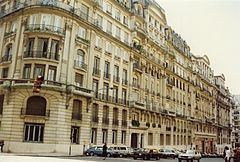Completed 1929 Opened 1929 Inaugurated 1929 | Address 1319 Esmeralda Country Argentina Client Alejandro Estrugamou Floors 6 Groundbreaking 1924 | |
 | ||
Architectural style Second Empire architecture in Europe Similar Palacio Haedo, Paz Palace, Monument to Giuseppe, Kavanagh building, Chacabuco Park | ||
The Estrugamou Building is an architecturally significant residential building in the Retiro area of Buenos Aires.
Contents
- Map of Estrugamou Building Cdad AutC3B3noma de Buenos Aires Argentina
- Overview
- Residents and Associated Personalities
- References
Map of Estrugamou Building, Cdad. Aut%C3%B3noma de Buenos Aires, Argentina
Overview
The landmark building was commissioned in 1924 by Alejandro Estrugamou, the son of immigrants from the Basses-Pyrénées area of France and a prominent Venado Tuerto (Santa Fe Province) landowner. Conceiving it as an investment property, Estrugamou himself lived in a relatively understated French Baroque mansion, nearby.
Designed by architects Eduardo Sauze y August Huguier, the building, like many of the upscale developments in Argentina during the early 20th century, was designed in an eclectic style heavily influenced by French Baroque and Second Empire architecture. The Estrugamou was built in four sections, arranged around a patio adorned with a bronze copy of the iconic Winged Victory of Samothrace. Nearly every decorative element of the building was imported from France, and the flooring was finished in Slavonian oak.
Inaugurated in 1929, the eight-story Estrugamou Building was one of the few city landmarks to receive no architectural awards at the time of its completion. It was graced by an oversized sidewalk and extensive garden along its southern façade originally, though the civic-minded Alejandro Estrugamou donated this section to the city (which sought to widen Juncal Street) shortly before his death in 1937. The Estrugamou building has been described as an 'oasis of glamour, diplomacy and politics' by virtue of its notable residents and associated personalities.
